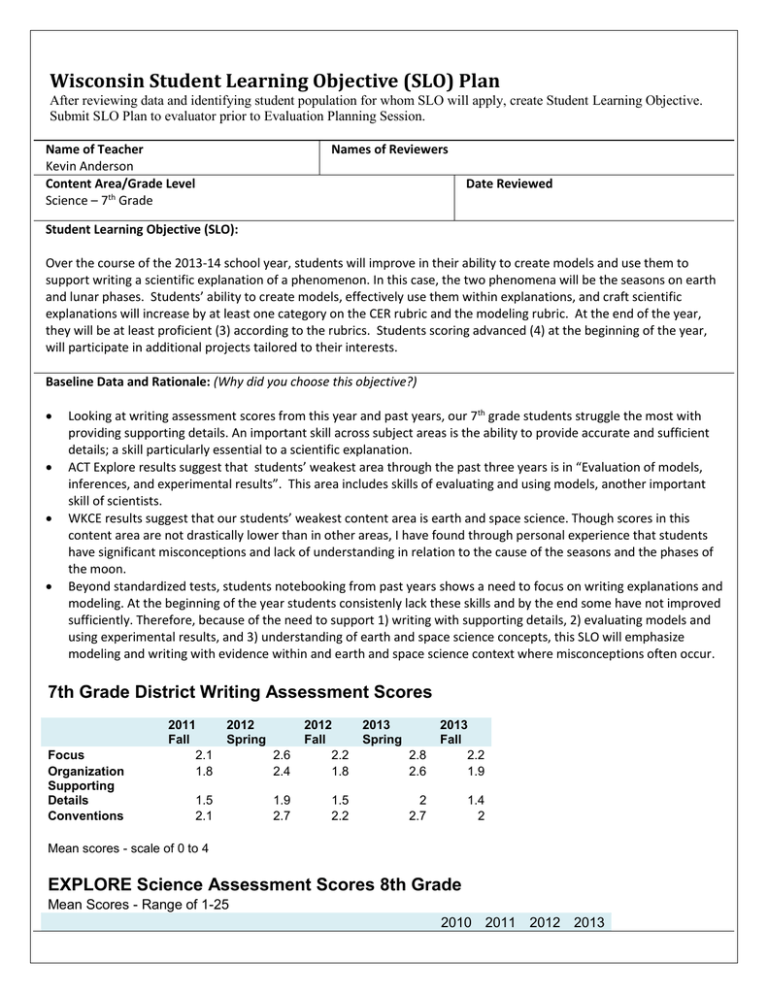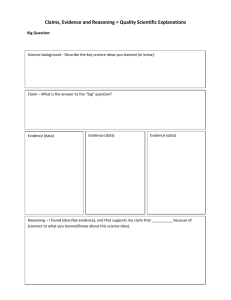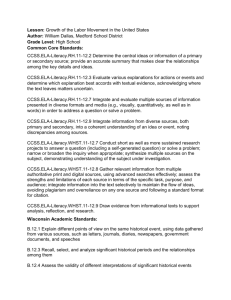My 7th grade science SLO
advertisement

Wisconsin Student Learning Objective (SLO) Plan After reviewing data and identifying student population for whom SLO will apply, create Student Learning Objective. Submit SLO Plan to evaluator prior to Evaluation Planning Session. Name of Teacher Kevin Anderson Content Area/Grade Level Science – 7th Grade Names of Reviewers Date Reviewed Student Learning Objective (SLO): Over the course of the 2013-14 school year, students will improve in their ability to create models and use them to support writing a scientific explanation of a phenomenon. In this case, the two phenomena will be the seasons on earth and lunar phases. Students’ ability to create models, effectively use them within explanations, and craft scientific explanations will increase by at least one category on the CER rubric and the modeling rubric. At the end of the year, they will be at least proficient (3) according to the rubrics. Students scoring advanced (4) at the beginning of the year, will participate in additional projects tailored to their interests. Baseline Data and Rationale: (Why did you choose this objective?) Looking at writing assessment scores from this year and past years, our 7th grade students struggle the most with providing supporting details. An important skill across subject areas is the ability to provide accurate and sufficient details; a skill particularly essential to a scientific explanation. ACT Explore results suggest that students’ weakest area through the past three years is in “Evaluation of models, inferences, and experimental results”. This area includes skills of evaluating and using models, another important skill of scientists. WKCE results suggest that our students’ weakest content area is earth and space science. Though scores in this content area are not drastically lower than in other areas, I have found through personal experience that students have significant misconceptions and lack of understanding in relation to the cause of the seasons and the phases of the moon. Beyond standardized tests, students notebooking from past years shows a need to focus on writing explanations and modeling. At the beginning of the year students consistenly lack these skills and by the end some have not improved sufficiently. Therefore, because of the need to support 1) writing with supporting details, 2) evaluating models and using experimental results, and 3) understanding of earth and space science concepts, this SLO will emphasize modeling and writing with evidence within and earth and space science context where misconceptions often occur. 7th Grade District Writing Assessment Scores Focus Organization Supporting Details Conventions 2011 Fall 2.1 1.8 2012 Spring 1.5 2.1 2.6 2.4 2012 Fall 2.2 1.8 1.9 2.7 1.5 2.2 2013 Spring 2.8 2.6 2013 Fall 2.2 1.9 2 2.7 1.4 2 Mean scores - scale of 0 to 4 EXPLORE Science Assessment Scores 8th Grade Mean Scores - Range of 1-25 2010 2011 2012 2013 Interpretation of Data Scientific Investigation Evaluation of Models, Inferences, and Experimental Results 19 18 21 15 19 16 18 15 13 11 12 14 Overall Score Mean College and Career Readiness Benchmark 16 17 17 16 18 18 18 18 Sample Science Assessment Data - WKCE 8th Grade Test Type WKCE WKCE WKCE WKCE Content Standard School Average District Average State Average My class Points Possible Average points earned in school Overall Applications & Social Perspectives Connections & Nature of Science WKCE Science Inquiry Life and Environment WKCE Earth and Space WKCE Physical Science 67.4 72.8 70.9 66.1 7 4.7 69.3 72.1 72.5 77.9 70.5 77.1 68.4 71.7 7 8 4.9 5.8 67.6 65.2 71.3 71.3 69.2 78 69.7 71.6 76.1 69.3 64.9 71.2 6 6 6 4.1 3.9 4.3 SCIENCE Minimal Performance Basic Proficient Advanced Fourth Grade 170-248 249-278 279-319 320-440 Eighth Grade 230-348 349-374 375-418 419-560 Tenth Grade 240-410 411-428 429-465 466-610 Scale Score 2012 398.6 Scale Score 2011 394.2 Scale Score 2010 395.1 Learning Content: (What content will the SLO address?) CCSS ELA Standards – Literacy in science CCSS.ELA-Literacy.RST.6-8.7 ; CCSS.ELA-Literacy.WHST.6-8.1a; CCSS.ELA-Literacy.WHST.6-8.1b; CCSS.ELALiteracy.WHST.6-8.1c; CCSS.ELA-Literacy.WHST.6-8.2b; CCSS.ELA-Literacy.WHST.6-8.2d In their scientific explanations, I want increased attention to the quality of details, requiring use of relevant, logical, and plausible support, as supported by a model of a phenomenon. Students need to move beyond unsubstantiated generalities. NGSS Performance Expectations MS-ESS1-1: Students will developing and use a model of the sun, moon and earth with graphical drawings to describe patterns in lunar phases and seasons and the reasons for these patterns. http://nextgenscience.org./msess1-earth-place-universe MS-ESS1-3: This PE on scale properties will be partially assessed, as students will be expected to describe scale properties of their models. NGSS Disciplinary Core Ideas MS-ESS1.A; MS-ESS1.B NGSS Science and Engineering Practices Developing and Using Models; Constructing Explanations NGSS Crosscutting Concepts Patterns; Scale, proportion and quantity; Systems and system models Student Population: (Who are you going to include in this objective?) All 7th grade science students in my 5 science courses (128 students total) Interval: (How long will you focus on this objective?) Full academic year – pre-test given in early September, post-test given in early June Assessment/Evidence Source(s): (How will you measure the outcome of your objective?) Task 1: Students will be asked to model two phenomena through scale diagrams. The phenomena will be the cause of the seasons and lunar phases. They will be told, “Draw a model of the earth, sun and moon that shows why we have seasons. Draw a second model that explains why we see different phases of the moon. Consider scale within your model.” Task 2: They will next be asked to write up a scientific explanation, referencing their models, for why we have seasons and why the moon has different phases. They will be shown the rubric for how the modeling and explanation will be assessed, though at the beginning of the year they will not be shown how well they did on the assessment. At the end of the year when they do the same tasks again, they will be shown their results and the class will discuss them. Targeted Growth: (What is your goal for student growth?) With this being the first year using this assessment and this learning objective (in this format), I do not have sense of what baseline growth through the year might be. Based on past years work, my students generally show a significant increase in being able to create and use models, and write explanations with evidence. Therefore, I will expect all students to make growth. I will use a tiered growth strategy. Students’ ability to create models, effectively use them within explanations, and craft scientific explanations will increase by at least one category on the CER rubric and the modeling rubric if they start at a 2 or 3 in a category. If they start at a zero, they will make at least two categories of growth. If they start with 3 or more 1’s, they will increase to at least a 2.5 average score across categories. I also expect growth from students receiving an advanced rating on this rubric (4). While they will maintain that advanced score, they will also show growth through completing personalized projects to extend their understanding of these astronomy disciplinary core ideas and the science and engineering practices. Their personalized projects will be scored on a separate project rubric, whereupon their sophistication of content understanding and use of scientific practices will show increase through the year. Strategies and Support (What methods or interventions will you use to support this objective?) Through the course of the year students will be asked to draw, build, and design a variety of models of phenomena. They will use these models in their explanations and refine these models as a class, in groups and individually, growing in ability to use these models and explain them as their understanding of science concepts increases. Using a variety of model types will help to differentiate material as well, with more sophisticated models being expected of advanced students, while a variety of simplified models will help students lacking understanding to better access the material. Students will use CER, modeling and other rubrics throughout year linked to different content areas as they assess their own work and peer’s work, and as the teacher explains expectations. Samples of effective work in these areas will be provided, as will scaffolding strategies including a CER template. Students’ scientific work will be linked to the world around them to deepen their understanding and be more culturally relevant. We will build on their observations of the sun and moon, for example, doing that type of realworld observational data gathering and explanation work across content through the year. As mentioned above, students scoring advanced in the beginning will receive additional project work to extend their learning. Students scoring at the 0 and 1 levels will receive targeted small group instruction using disciplinary reading strategies to build understanding, and guided practice in modeling and writing explanations.








